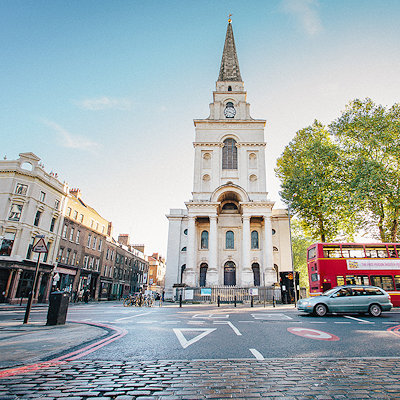
Like us on Facebook
PLACE NAMES


 
|
|
Bethnal Green
|

|
|
|
Bethnal Green is a district mostly in the London Borough of Tower Hamlets and partly in the London Borough of Hackney. Located 3.3 miles (5.3 km) northeast of Charing Cross, it was historically a hamlet in the ancient parish of Stepney, Middlesex.
Following population increases caused by the expansion of London during the 18th century, it was split off from Stepney as the parish of Bethnal Green in 1743, becoming part of the Metropolis in 1855 and the County of London in 1889. The parish became the Metropolitan Borough of Bethnal Green in 1900 and the population peaked in 1901, entering a period of steady decline which lasted until 1981.
The economic history of Bethnal Green is characterised by a shift away from agricultural provision for the City of London to market gardening, weaving and light industry, which has now all but disappeared. The quality of the built environment had deteriorated by the turn of the 20th century and was radically altered by the aerial bombardment during the Second World War and the subsequent social housing developments. Some 173 people were killed at a single incident at Bethnal Green tube station in 1943. Bethnal Green has formed part of Greater London since 1965.
The place-name Blithehale or Blythenhale, the earliest form of Bethnal Green, is derived from the Anglo-Saxon healh ("angle, nook, or corner") and blithe ("happy, blithe"), or from a personal name Blitha. Nearby Cambridge Heath (Camprichesheth), is unconnected with Cambridge and may also derive from an Anglo-Saxon personal name. The area was once marshland and forest which, as Bishopswood, lingered in the east until the 16th century. Over time, the name became Bethan Hall Green, which, because of local pronunciation as Beth'n 'all Green, had by the 19th century changed to Bethnal Green.
To the east of Bethnal Green (and west of Bow and north of Stepney Green) lies Globe Town, established from 1800 to provide for the expanding population of weavers around Bethnal Green attracted by improving prospects in silk weaving. The population of Bethnal Green trebled between 1801 and 1831, operating 20,000 looms in their own homes. By 1824, with restrictions on importation of French silks relaxed, up to half these looms became idle and prices were driven down. With many importing warehouses already established in the district, the abundance of cheap labour was turned to boot, furniture and clothing manufacture. Globe Town continued its expansion into the 1860s, long after the decline of the silk industry.
Globe Town has three globe sculptures situated in three corners of the area. The town centre is known as Globe Town Market Square, and is located to the north on Roman Road next to the Cranbrook Estate. The area is home to a large Bangladeshi community.
This area as with greater Bethnal Green is served by Bethnal Green and Stepney Green underground stations. London Buses routes 309 serves the heart of Globe Town with 8, D6 and night route N8 on the north on Roman Road and 25, 205 and N205 on Mile End Road in Stepney Green to the south.
|
 Feel free to Email me any additions or corrections Feel free to Email me any additions or corrections
LINKS AVAILABLE TO YOUR SITE
| |





